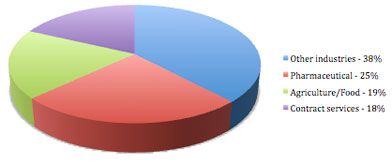Market Profile: Supercritical Fluid Chromatography
Supercritical fluid chromatography (SFC) makes use of a supercritical fluid, typically carbon dioxide, instead of an organic or aqueous solvent, to carry the sample through the chromatography column.
Supercritical fluid chromatography (SFC) makes use of a supercritical fluid, typically carbon dioxide, instead of an organic or aqueous solvent, to carry the sample through the chromatography column. The advantages of SFC when using carbon dioxide are that there are no organic solvents to dispose of. Separations can also be performed more quickly than with high performance liquid chromatography (HPLC), because the diffusion of solutes in supercritical fluids is about an order of magnitude greater than in liquids. While initially more of an analytical technique, SFC has developed into primarily a preparative technique, and it is also now seeing significant use in process-scale chromatography.

Purification SFC demand by industry for 2011
The nontoxic nature of carbon dioxide as a solvent is a very attractive feature of SFC when working with products intended for human consumption. SFC is also a particularly attractive separation method for chiral compounds because of its efficient use of chiral stationary phase (CSP) media and the fact that SFC provides a compatible environment for CSP media. These factors make SFC particularly attractive to both the pharmaceutical and agriculture–food industries.
The demand for purification SFC is still being driven by solid niche areas, many of which are related to chiral separations. Most of the demand for purification SFC comes from laboratory-scale preparative applications. Larger-scale pilot and production SFC systems are gradually becoming a more important part of the market as the technique becomes more established and developed for purification applications. Currently, the pharmaceutical, agriculture–food, and contract research services sectors account for nearly two-thirds of the global SFC demand.
The foregoing data were extracted from SDi’s recently published Market Analysis and Perspectives report titled Purification Chromatography: The Key to the Biopharmaceutical Industry. For more information, contact Glenn Cudiamat, VP of Research Services, Strategic Directions International, Inc., 6242 Westchester Parkway, Suite 100, Los Angeles, CA 90045, tel. (310) 641-4982, fax (310) 641-8851, e-mail cudiamat@strategic-directions.com
Regulatory Deadlines and Supply Chain Challenges Take Center Stage in Nitrosamine Discussion
April 10th 2025During an LCGC International peer exchange, Aloka Srinivasan, Mayank Bhanti, and Amber Burch discussed the regulatory deadlines and supply chain challenges that come with nitrosamine analysis.
Top Execs from Agilent, Waters, and Bruker Take the Stage at J.P. Morgan Healthcare Conference
January 16th 2025The 43rd Annual Healthcare J.P. Morgan Healthcare Conference kicked off in San Francisco earlier this week. Here’s what top executives from Agilent, Bruker, and Waters, discussed during the event.

.png&w=3840&q=75)

.png&w=3840&q=75)



.png&w=3840&q=75)



.png&w=3840&q=75)

